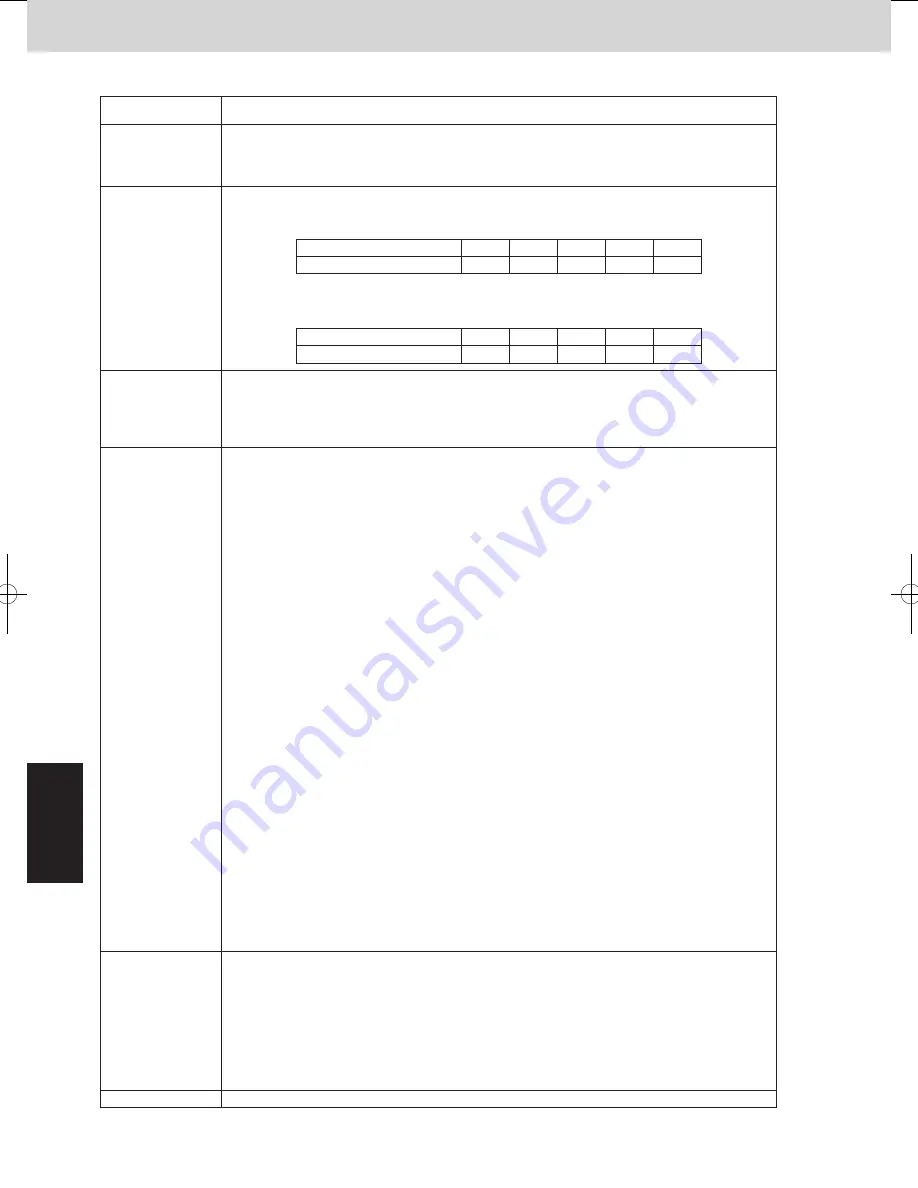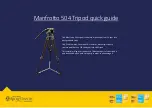
6
- 18
2WAY SYSTEM
Trouble Diagnosis
6
4. 2WAY Alarm Codes
2WAY SYSTEM
Trouble Diagnosis
4. 2WAY Alarm Codes
H11, H12, H21, H22 Alarm
Alarm code
H11, H12, H21, H22
Alarm meaning
H11:
H12:
H21:
H22:
Constant speed compressor 2 overcurrent alarm
Constant speed compressor 2 lock current alarm
Constant speed compressor 3 overcurrent alarm
Constant speed compressor 3 lock current alarm
During operation, when the compressor current value exceeds the following values
for 30 seconds or longer listed below table.
However this alarm is not detected for 4 seconds after the compressor starts.
H11, H21:
Alarm conditions
Probable cause
(1) Compressor failure (locked or partially locked)
(2) CT circuit failure (including wiring disconnection)
(3) Missing power phase
(4) Low power voltage
(5) PCB failure
Check
(1) Compressor failure (partially locked)
Trouble: Current value during operation greatly exceeds the value shown above.
Check: When the current for each phase is measured with a clamp meter or similar
instrument, check that the current value for all phases is not high. If MG was forced
ON (use caution), check that compressor noise will not occur or the compressor
will not run with a groaning sound.
(2) CT circuit failure, PCB failure
Trouble:
Check: • Check for poor connector contact.
Check the continuity of the CT circuit.
Install a normal CT in place of this CT and check. If current is detected, then the
PCB can be judged OK.
CT circuit failure
→
→
Check that current is flowing in the phase where the CT circuit is connected.
Check voltage and current.
(3) Missing power phase
Trouble: This alarm primarily occurs when the T-phase is missing. When the R-phase or
S-phase is missing, CT trouble or PCB continuity trouble occur. However this may not
be true in the case of a missing phase caused by magnet SW trouble.
Check: There is the possibility of a magnet SW failure. Therefore, check the phase voltage at
a location that is as close to the compressor as possible.
(4) Low power voltage
Trouble: In most cases, this occurs when another constant-speed compressor (including
compressors in other units) or other device starts. It also occurs when the power
wiring is extremely long.
Check: Check the voltage between each of the phases. However if this trouble occurs when
other devices or compressors start, then an oscilloscope is required.
(5) PCB failure
Trouble:
Check: Check that the current value measured with the clamp meter is not lower than the
value measured with the PC or remote controller.
If the cause is still unknown after checking the above, then it is possible that noise is the
(6)
cause of the trouble. It is necessary to connect a PC or other instrument.
•
•
•
Correction
(1) Replace the compressor.
(2) Replace the CT circuit.
(3) Repair the power circuit.
(4) Adjust the primary-side power. Repair the power wiring.
(5) Replace the outdoor unit PCB.
(6) Correct the trouble.
* In the case of a compressor failure, it is likely that steps must be taken to correct the cause
of the compressor failure (such as liquid back-up) in order to prevent recurrence. Be sure to
check that there is no cause which may result in compressor locking.
Example
—
Horsepower of outdoor unit
Overcurrent (A)
12HP
16.3
14HP
13.6
16HP
16.3
18HP
13.6
20HP
16.3
During operation, when the compressor current value exceeds the following values
for 4 seconds or longer listed below table.
However this alarm is not detected for 2 seconds after the compressor starts.
H12, H22:
Horsepower of outdoor unit
Overcurrent (A)
12HP
19.3
14HP
16.1
16HP
19.3
18HP
16.1
20HP
19.3
H03, H13, H23 Alarm
2WAY SYSTEM
Trouble Diagnosis
4. 2WAY Alarm Codes
H05, H15, H25 Alarm
Alarm code
H05, H15, H25
Alarm meaning
H05 : Compressor 1 discharge temperature sensor disconnected
H25 : Compressor 3 discharge temperature sensor disconnected
Alarm conditions
This alarm occurs when the discharge sensor temperature detector is not inserted into the tube’s
sensor holder, or when the sensor itself has suffered some kind of malfunction other than a cut
wire.
When outdoor air temperature is -10°C or higher:
Alarm occurs if the temperature detected by the discharge sensor has changed by less than
2°C when the compressor has operated for 10 minutes immediately after start.
When outdoor air temperature is below -10°C:
Alarm occurs if the temperature detected by the discharge sensor has changed by less than
2°C when the compressor has operated for 30 minutes immediately after start.
•
•
•
Probable cause
(2) Discharge sensor itself has suffered some kind of malfunction other than a cut wire.
Check
(1) Discharge sensor temperature detector is not inserted into the tube’s sensor holder.
(1) Check that the discharge temperature sensor is inserted into the sensor holder.
(2) Check that sufficient heat-conducting putty is applied.
(3) Remove the discharge sensor from the sensor holder and expose the sensor to the outside
air for approximately 5 minutes. Check that the temperature detected by the sensor changes
to match the outside air temperature. (However the sensor cannot detect temperatures at or
below 0 °C.)
Correction
(1) Install the sensor into the holder, and apply sufficient heat-conducting putty.
(2) If the sensor is malfunctioning, replace it.
Example
H15 : Compressor 2 discharge temperature sensor disconnected
Alarm code
H03, H13, H23
Alarm meaning
H03 : Compressor 1 CT sensor disconnected or short-circuit
H23 : Compressor 3 CT sensor disconnected or short-circuit
Alarm conditions
Compressor 1:
Compressor 2, 3:
When the compressor 1(INV) is stopped, the primary current detected over 18A.
Current values at compressor 2 and 3 are less than 2.0 A when 2 seconds or more
had passed after the compressors began operation and output.
When the frequency of compressor 1(INV) is over 35Hz and the secondary current
is over 7.0A, the primary current detected lower than 0.7A.
* No current is detected even though the compressors are operating.
Probable cause
(2) Disconnected CT circuit connector
(3) Missing phase where CT circuit is connected
(4) This CT circuit is connected to the connector of the other CT circuit.
(5) PCB failure
(6) Electrical noise
Check
(1) CT circuit failure (including cut wiring, etc.)
(1) CT circuit failure, PCB failure
Trouble:
• Current v
alue during compressor operation is below the threshold value.
Check:
• Che
ck that the connector is not disconnected.
Check the continuity of the CT circuit.
Install a normal CT in place of this CT and check. If current is detected, then the
PCB can be judged OK.
CT circuit failure
Check that current is flowing in the phase where the CT circuit is connected.
Check voltage and current.
(2) Crossed wiring or installation error
Trouble: When the compressor is stopped, the current value at the other compressor is high.
When this type of condition occurs, seizing-detection control takes priority.
(3) If the cause is still unknown after checking the above, then it is possible that noise is the
cause of the trouble. It is necessary to connect a PC or other instrument.
•
•
•
Correction
(1) Replace the CT circuit.
(2) Replace the outdoor unit PCB.
(3) Correct the problem.
Example
(1) The connector was not inserted after the PCB was replaced.
Notes
Use a normal CT as a tool to determine whether the trouble is a PCB failure or CT failure.
H13 : Compressor 2 CT sensor disconnected or short-circuit
SM830204-05_2WAY SYS.indb 18
2015/01/20 17:45:19
Содержание U-20ME1E81
Страница 54: ... MEMO 1 46 ...
Страница 102: ... MEMO 3 36 ...
Страница 116: ... MEMO 4 14 ...
Страница 177: ...201502 ...
















































